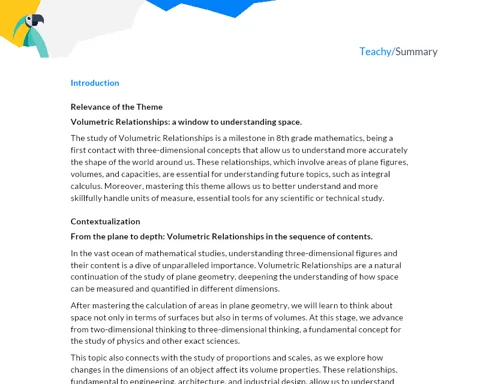Rotations: Mastering Isometric Transformations
Objectives
1. Understand the importance of isometric transformations, especially rotation, in the context of geometric problems and their practical applications.
2. Develop skills to rotate figures and describe the results obtained.
3. Learn to find the points of rotated figures on a plane.
4. Utilize concepts of isometric transformations (translation, reflection, rotation, and compositions of these) in geometric problems.
Contextualization
Rotations are a fundamental concept in geometry, with various practical applications. For example, a civil engineer needs to understand how objects behave when rotated to design a bridge. Similarly, a graphic designer uses rotations when creating logos. The ability to visualize and manipulate rotations is essential not only in academic contexts but also in various professions. In movie and game animations, rotating figures is crucial for giving movement and realism to characters. In mechanical engineering, rotation is fundamental for designing machine components, such as gears and motors.
Relevance of the Theme
The topic of rotations is extremely relevant in the current context, as its applications range from creating digital animations to designing mechanical components. Understanding and applying isometric transformations is crucial for solving practical problems and innovating in various professional areas, such as engineering, graphic design, and computing. Moreover, these skills are highly valued in the job market, preparing students to face real challenges.
Definition and Properties of Rotations
Rotations are geometric transformations that move points of a figure along a circle around a fixed point, called the center of rotation. The rotation is characterized by an angle that determines the magnitude and direction of the movement.
-
Fixed point (center of rotation): is the point around which the figure is rotated.
-
Rotation angle: measures the degree and direction of the rotation, which can be positive (counterclockwise) or negative (clockwise).
-
Isometric transformation: rotation preserves distances and angles, maintaining the shape and size of the original figure.
Center of Rotation and Rotation Angle
The center of rotation is the fixed point around which a figure is rotated, while the rotation angle determines the extent and direction of the figure's movement around that point.
-
Center of rotation: can be inside, outside, or on the figure being rotated.
-
Rotation angle: defines how many degrees the figure will be rotated and in which direction.
-
Coordinates after rotation: the position of the points of the figure after rotation can be determined using specific transformation formulas.
Isometric Transformations
Isometric transformations include rotations, translations, and reflections, characterized by preserving distances and angles, maintaining the shape and size of geometric figures.
-
Translation: moves all points of a figure in the same direction and distance.
-
Reflection: mirrors the figure with respect to a line (axis of reflection).
-
Composition of transformations: combines multiple isometric transformations to obtain a new result.
Practical Applications
- Character Animation: Rotations are used to give movement and realism to characters in movies and games.
- Mechanical Engineering: Designing components like gears and motors depends on understanding rotations.
- Graphic Design: Creating logos and graphics involves manipulating figures through rotations to achieve the desired design.
Key Terms
-
Center of Rotation: Fixed point around which a figure is rotated.
-
Rotation Angle: Measure of the degree and direction of a figure's rotation.
-
Isometric Transformation: Transformation that preserves distances and angles, maintaining the shape and size of figures.
-
Translation: Movement of all points of a figure in the same direction and distance.
-
Reflection: Mirroring of a figure with respect to a line.
Questions
-
How can the understanding of rotations influence the design of a product or an animation?
-
In what ways are isometric transformations applied in different professional contexts?
-
What challenges have you faced when trying to visualize and apply rotations in geometric figures?
Conclusion
To Reflect
Throughout this lesson, we explored how rotations and other isometric transformations are applied in various contexts, from character animation in movies and games to the design of mechanical components. Understanding these transformations is crucial for solving geometric problems and innovating in fields such as engineering, graphic design, and computing. The ability to visualize and manipulate figures through rotations not only strengthens mathematical understanding but also prepares students to face real challenges in the job market. By connecting theory and practice, we reinforce the importance of these skills in their future professional careers.
Mini Challenge - Drawing a Gear Wheel
In this mini-challenge, you will apply the concepts of rotation to draw a gear wheel using simple materials. You will need to calculate the necessary rotation angles for the gears to move correctly and assemble a mechanism that demonstrates the rotation.
- Form groups of 3 to 4 people.
- Draw and cut gears of different sizes from cardboard.
- Calculate the rotation angles necessary for the gears to move in sync.
- Use pivot pins to secure the gears to a cardboard base, allowing them to rotate.
- Test the mechanism and make necessary adjustments to ensure the gears function correctly.



